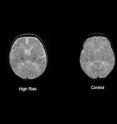Brain signs of schizophrenia found in babies
Schizophrenia is a debilitating mental disorder affecting one in 100 people worldwide. Most cases aren't detected until a person starts experiencing symptoms like delusions and hallucinations as a teenager or adult. By that time, the disease has often progressed so far that it can be difficult to treat. In a paper published recently online by the American Journal of Psychiatry, researchers at the University of North Carolina at Chapel Hill and Columbia University provide the first evidence that brain abnormalities associated with schizophrenia risk are detectable in babies only a few weeks old.
"It allows us to start thinking about how we can identify kids at risk for schizophrenia very early and whether there things that we can do very early on to lessen the risk," said lead study author John H. Gilmore, MD, professor of psychiatry and director of the UNC Schizophrenia Research Center.
The scientists used ultrasound and MRI to examine brain development in 26 babies born to mothers with schizophrenia. Having a first-degree relative with the disease raises a person's risk of schizophrenia to one in 10. Among boys, the high-risk babies had larger brains and larger lateral ventricles—fluid-filled spaces in the brain—than babies of mothers with no psychiatric illness.
"Could it be that enlargement is an early marker of a brain that's going to be different?" Gilmore speculated. Larger brain size in infants is also associated with autism.
The researchers found no difference in brain size among girls in the study. This fits the overall pattern of schizophrenia, which is more common, and often more severe, in males.
The findings do not necessarily mean the boys with larger brains will develop schizophrenia. Relatives of people with schizophrenia sometimes have subtle brain abnormalities but exhibit few or no symptoms.
"This is just the very beginning," said Gilmore. "We're following these children through childhood." The team will continue to measure the children's brains and will also track their language skills, motor skills and memory development. They will also continue to recruit women to the study to increase the sample size.
This research provides the first indication that brain abnormalities associated with schizophrenia can be detected early in life. Improving early detection could allow doctors to develop new approaches to prevent high-risk children from developing the disease. "The research will give us a better sense of when brain development becomes different," said Gilmore. "And that will help us target interventions."
Source: University of North Carolina School of Medicine
Other sources
- Brain signs of schizophrenia found in babiesfrom Science DailyTue, 22 Jun 2010, 3:31:36 UTC
- Brain signs of schizophrenia found in babiesfrom PhysorgMon, 21 Jun 2010, 18:31:32 UTC
- Brain signs of schizophrenia found in babiesfrom Science BlogMon, 21 Jun 2010, 15:00:45 UTC
